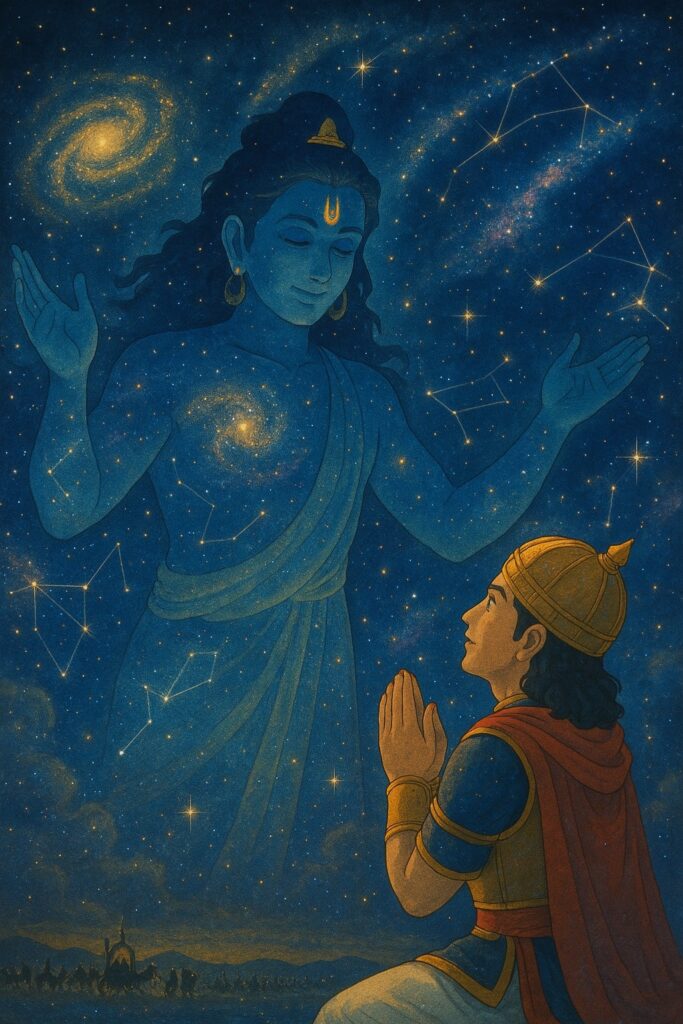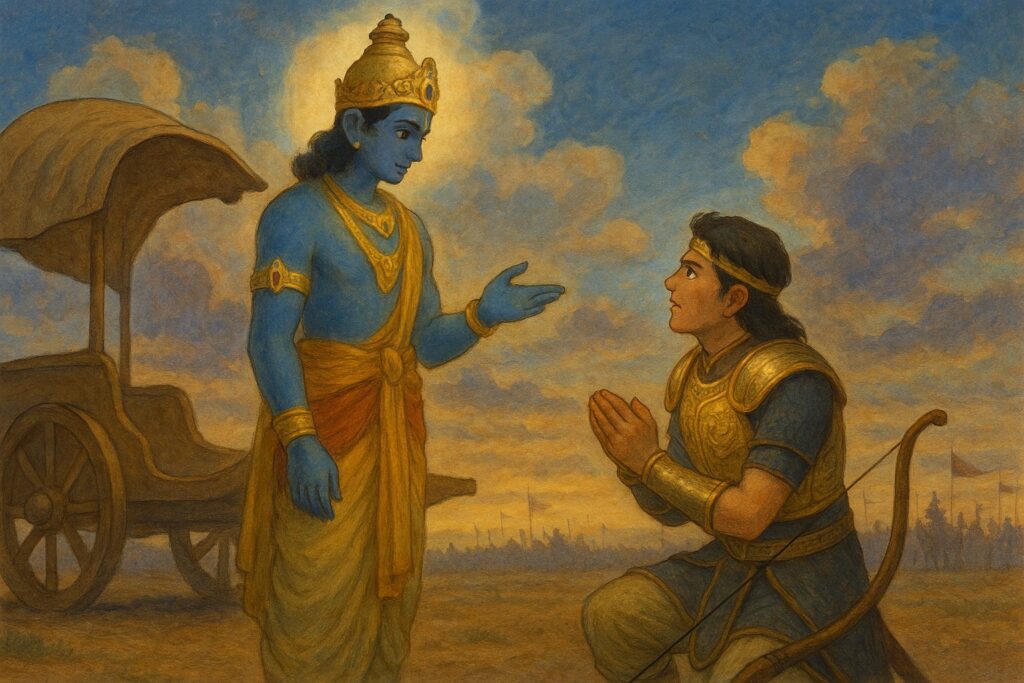Date: April 8, 2025
Part 2: Why Study the Scriptures?
Continued from Part 1
We begin our study of Bhagavad Gita by becoming aware of what we seek when we study any scripture such as the Gita, what may be the limitation of our instrument, and how to avoid the trapping of the limits of our reason. We are guided in this by Sri Aurobindo.
Sri Aurobindo, in the opening paragraph of the first essay titled ‘Our Demand and Need from the Gita,’ in his volume Essays on the Gita reminds us that we approach the scriptures because we seek a Truth that is one and eternal, a Truth from which all other truth derives, by the light of which all other truth finds its right place, explanation and relation to the scheme of knowledge. But we must also know that because this eternal Truth is infinite in its vastness and depth it cannot be shut up in a single trenchant formula. Nor it is likely to be found in its entirety or in all its bearings in any single philosophy or scripture or uttered altogether and forever by any one teacher, thinker, prophet or Avatāra.
More importantly, Sri Aurobindo goes on to explain, this Truth cannot be wholly found by us if our view of it necessitates the intolerant exclusion of the truth underlying other systems. Because when we reject passionately, it simply means that we cannot appreciate and explain. This Truth, though it is one and eternal, expresses itself in Time and through the mind of man. Therefore, every scripture must necessarily contain two elements: one temporary, perishable, belonging to the ideas of the period and country in which it was produced; and the other which is eternal and imperishable, and applicable in all ages and countries.
We must also recognize that the specific form in which the Truth is stated, the metaphysical and intellectual mould in which it is systematized, and its precise expression are largely subject to the mutations of Time. Over the course of time, these outer forms and expressions cease to have the same force because of the constant modifications in the human intellect. It is the nature of human intellect to continually divide and put together its divisions and to rearrange its syntheses, says Sri Aurobindo.

He further adds that human intellect has a tendency and preference to continually leave old expression and symbol for new. Or if it continues to use the old symbolism and expression, it changes its connotation or at least its exact content and association so much so that one can never be certain of understanding an ancient book precisely in the original sense and spirit intended for that time and context. This is one of the main reasons why contemporary retellings of Indian epics such as the Ramayana or the Mahabharata, or of the many stories from the Puranas often fail to stay true and sincere to the original intent, purpose and spirit of these ancient stories and legends.
But we must also know that behind all these outer mutable forms of the expression of the eternal and one Truth, “what is of entirely permanent value is that which besides being universal has been experienced, lived and seen with a higher than the intellectual vision” (Sri Aurobindo, CWSA, Vol. 19, p. 5). It is that which we seek when we approach a scripture.
Problems When Approaching a Scripture
Sri Aurobindo speaks of a fundamental problem faced by the human mind when approaching any scripture. He explains that this problem arises because of the limited nature of human mind which attaches itself exclusively to a particular scripture, and claims that scripture alone to be the eternal Word of God. This mental clinging also leads to the claim that all other scriptures are either impostures or at best imperfectly inspired, and the truth rests only with the one particular scripture to which the mind has attached itself exclusively.
Sri Aurobindo reminds that often even the wise people because of intellectual egoism or spiritual pride buy into such “bigoted exclusions and vain wranglings.” (ibid., p. 3) Given this tendency of the limited, un-refined human mind to not only exclusively cling to some specific scripture or some teaching and claim it to be the only and the absolute Truth, but also to impose or force upon others that scripture or teaching, what should be the right way to approach our ancient scriptures? What is it that seek from our study of scriptures that is of value to humanity in the present as well as the future?

Limitations of Human Interpretation
“The word of Scripture is infallible; it is in the interpretation the heart and reason put upon the Scripture that error has her portion.”
~ Sri Aurobindo, CWSA, Vol. 12, p. 434
The above aphorism states an important truth which demands our sincere attention when studying any spiritual scripture, especially when we read interpretive commentaries made by various spiritual masters and philosophers. Here Sri Aurobindo essentially warns us of the limitation of human interpretation and reason, the bias and prejudice of the un-trained and un-purified human mind and heart, all of which create error and misunderstanding of the truth that the scripture is expressing.
In an essay titled, ‘The Interpretation of Scripture,’ Sri Aurobindo lists the qualities that an interpreter of scripture must possess if he intends to get close to the true spirit of the Word of the scripture. The interpreter cannot be too careful or too perfectly trained, because the knowledge the scripture conveys is deep, difficult and subtle. One must not rest content in the thought-symbol or in the logical implications of the idea expressed in the scripture. Rather, one must constantly yearn and seek for what is beyond the letter or the symbol.
The interpreter who cannot go beyond the external meaning is the prisoner of his or her thought and rests in a partial and incomplete knowledge. He or she must “transgress limits and penetrate to the knowledge behind, which must be experienced before it can be known; for the ear hears it, the intellect observes it, but the spirit alone can possess it. Realisation in the self of things is the only knowledge; all else is mere idea or opinion.” (ibid., p. 34)
We are reminded of the need for an inner experience of the truth of the scripture, the realization in the self, the need to go beyond the intellectual understanding of the word or the idea. Sri Aurobindo, in the same essay, also reminds us that when we approach a scripture we must not rely exclusively on the commentaries or interpretations, rather we must make our own inquiry into the original text of the scripture.
Thus, to truly and fully experience the truth of the scripture, an inner realisation is demanded, something that is not the work of intellect or reason. It calls for other faculties beyond the mind, it calls for an inner growth of the consciousness, it calls for sādhana – the disciplined pursuit of a deeper truth and reality.
“To understand Scripture, it is not enough to be a scholar, one must be a soul. To know what the drashta [the seer of the scripture] saw one must oneself have drishti, sight, and be a student if not a master of the knowledge. …. Grammar, etymology, prosody, astronomy, metaphysics, logic, all that is good; but afterwards there is still needed the higher knowledge by which the Immutable is known.” (ibid., p. 37)
